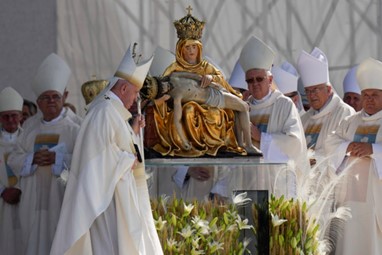On September 15, Slovaks across the world honor their patron saint, Our Lady of Seven Sorrows. This holiday is not only a celebration of faith but a testament to the deep roots that bind Slovaks to their homeland. Let’s explore the significance of the Marian Cult in Slovakia and why Our Lady of Sorrows has been a source of comfort and strength for centuries.

The Feast of Our Lady of Seven Sorrows commemorates the Virgin Mary’s resilience and pain, as she endured unimaginable suffering throughout her extraordinary life. The Holy See officially proclaimed her the patron saint of Slovakia in 1927, but Slovaks' devotion to Our Lady of Sorrows goes back much further. In their darkest moments, from brutal wars to pandemics, Slovaks have turned to her for solace and protection.

Slovakia, a nation forged through centuries of religious, social, and political upheaval, has always found hope in the figure of the Virgin Mary. She reminded Slovaks that God had not forsaken them and that they were never alone in their suffering. The Marian devotion that began centuries ago continues to offer strength and unity to Slovaks today.
The Cult of Our Lady of Seven Sorrows began in Eastern Christianity in the 4th century and spread to the West during the Middle Ages. By the 11th century, churches dedicated to her appeared across Europe, and in 1727, her feast day was universalized by the Catholic Church. Since 1913, it has been celebrated annually on September 15th.
In Slovakia, devotion to Our Lady of Sorrows grew after the Mongol invasion in the 13th century and surged during the Ottoman occupation in the 16th and 17th centuries. The oldest shrine dedicated to Our Lady of Sorrows dates back to 1245, a powerful testament to the enduring nature of the Slovak faith.
At the heart of this devotion is the Basilica of Our Lady of Sorrows in Šaštín, a pilgrimage site that has drawn countless worshippers for over 450 years. The basilica is home to a miraculous statue of the Virgin Mary, which was installed by Countess Angelika Bakič in the 16th century, in gratitude for an answered prayer. In 1732, after a series of miraculous healings and mysterious lights surrounding the chapel, the statue was officially declared miraculous, leading to the construction of the grand basilica we know today.

For centuries, pilgrims have flocked to Šaštín, seeking comfort, healing, and hope. The annual national pilgrimage held on September 15th is one of the most important religious events in Slovakia, drawing thousands of worshippers from around the world.
The significance of Our Lady of Sorrows extends beyond Slovakia. In 1995, during Slovakia’s turbulent transition from communism to democracy, Pope John Paul II visited Šaštín. His Mass, attended by over 400,000 pilgrims, offered hope to a country finding its place in a new democratic Europe.

Most recently, in 2021, Pope Francis followed in his predecessor’s footsteps, visiting Šaštín during the global COVID-19 pandemic. His visit, like that of John Paul II, underscored the enduring relevance of Our Lady of Sorrows as a beacon of hope during times of global suffering.
As Slovaks gather at shrines across the country today, they honor an unwavering devotion that has stood the test of time. The Feast of Our Lady of Seven Sorrows is more than just a national holiday, it is a symbol of Slovakia’s resilience, faith, and the enduring power of its heritage.
As Slovaks gather at shrines across the country today, they honor an unwavering devotion that has stood the test of time. The Feast of Our Lady of Seven Sorrows is more than just a national holiday, it is a symbol of Slovakia’s resilience, faith, and the enduring power of its heritage.
Team Global Slovakia





Comments